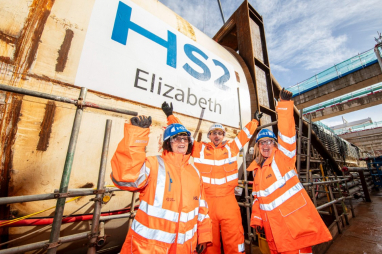
Second tunnel boring machine starts digging towards Birmingham
HS2 has launched the last tunnel boring machine (TBM) to dig tunnels for the new high speed railway in the West Midlands.
The 125-metre-long TBM has started on its journey to dig the second bore of HS2’s Bromford Tunnel, between the east portal at Water Orton in North Warwickshire and the west portal at Washwood Heath in Birmingham.
The 3.5-mile twin-bore tunnel will take high speed trains in and out of Birmingham, with a series of viaducts between Washwood Heath and Curzon Street Station taking trains to the city centre.
The first TBM, which launched in June 2023 and was named Mary Ann - the real name of Warwickshire-born author George Eliot - has completed around a third of her journey digging towards Birmingham.
So far, the machine has tunnelled under the Park Hall Nature Reserve, is currently near the River Tame, and will continue adjacent to the M6 at a depth of 27 metres before breaking through at Washwood Heath later this year.
The second TBM is due to finish its journey in autumn 2025.
The full Bromford Tunnel programme is being delivered by around 450 people working for HS2’s contractor Balfour Beatty VINCI (BBV).
A specialist tunnelling team working for BBV’s sub-contractors Tunnelcraft and Solihull-based Rorcon, are operating both TBMs 24/7, with each bore taking around 16 months.
Following the tradition of naming HS2 TBMs after famous women from the local area, pupils from Paget Primary School in Birmingham chose to call the machine Elizabeth after Dame Elizabeth Cadbury, who spent her life campaigning for the education and welfare of women in Birmingham.
The name was unveiled on site by Lucy Holmes - forest school lead at Paget Primary School and Diane Donaldson - Birmingham City Councillor for Bromford and Hodge Hill Ward.
Catherine Loveridge, HS2’s senior project manager said: “It’s fantastic to see this last West Midlands TBM get underway, marking another key moment for HS2 in the region.
“We’re now at peak construction on the project, delivering these massive feats of engineering using many local companies and local skills.
“Over a third of our total HS2 workforce are based at worksites across the West Midlands, and thousands more jobs are still to be created locally as work to build Curzon Street Station, Interchange Station and the Washwood Heath Depot gathers momentum.”
Jules Arlaud, Tunnelling Director for Balfour Beatty VINCI, added: “As Mary Ann continues her journey towards Washwood Heath in Birmingham, we’re now looking forward to having two machines underground, as this fascinating and complex stretch of the HS2 route inches another step closer to completion.”